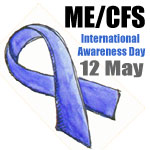
“Sleep is that golden chain that ties health and our bodies together.” –Thomas Dekker
M.E. patients are often nocturnal creatures- not by choice but as a consequence of their illness. It is a bitter irony that many of us feel the desperate need for sleep during the daylight hours but as soon as nightfall sets in, so does the insomnia or unrefreshing sleep. This blog entry will examine the myriads of potential sleep treatments that the ME/CFS experts of the world prefer. Following this, I will detail my experiences over the years with both sleep enhancing supplements and prescription drugs.
Sleep Treatments the ME/CFS Specialists Recommend
It is imperative that I mention that some of these specialists’ recommended treatments are sleep initiators while others are sleep prolongers.
Dr. Cheney
Dr Cheney is an advocate of Klonopin and likes using Doxepin Elixir drops in synchronicity with the Klonopin. He states that B12 in the form of hydroxocobalamin injections may help sleep, it taken at night. Magnesium also plays a pivotal part in Dr. Cheney’s sleep repertoire and he prefers it in the form of magnesium glycinate.
Dr. Teitelbaum
Dr. Teitelbaum’s approach towards patients’ sleep is multi-faceted. He emphasises that quality sleep is utterly fundamental so much so that his ‘SHINE’ protocol starts with ‘S’ for sleep. Dr. Teitelbaum thinks patients can get the greatest benefit from sleep aids by taking small amounts of as many different sleep aids as required to a maximum of “5 or 6.” He sells his own OTC sleep formula that contains many of the ingredients that he believes helps CFS patients sleep. The supplements Dr. Teitelbaum is an advocate of include; Suntheanine, Wild Lettuce, Jamaican Dogwood, Hops, Passionflower and Valerian. The medications he writes fondly of for sleep, in the order that he generally prescribes them for CFS patients are; Ambien, Trazodone, Klonopin, Gabapentin, Doxylamine (OTC), Carisoprodol, Doxepin, Cyclobenzaprine, Tizanidine and Zaleplon. He describes some patients needing to try different medications and other patients requiring a different order of trial to the above sequence.
Dr. Klimas
Dr. Klimas states that sleep improvement isn’t as easy as taking a magic pill. She believes that patients who wake up exhausted require a sleep study that takes place in a specialised sleep lab. The sleep study will determine if the sleep problems are caused by a characterised sleep disorder such as sleep apnea. The study will also document sleep patterns including the need for stage 3 and 4 sleep. Dr. Klimas believes treatment can then proceed following the results of the sleep study. When Dr. Klimas does prescribe sleep drugs, she avoids the likes of Ambien and Restoril believing that they don’t promote quality sleep, instead just instigating sleep. Dr. Klimas is mainly an advocate of Elavil and Doxepin. She also likes Flexeril and Klonopin.
Dr. Lapp
Dr. Lapp shares a similar penchant to Dr. Cheney for Klonopin used in tandem with Doxepin, both at a low dosage. He also emphasises that patients needn’t start with prescription drugs for sleep. He thinks milder sleep problems may be quashed by the use of; Valerian, Excedrin PM, Tylenol PM and Melatonin. Trazodone, hypnotic drugs and SSRIs are all sleep treatment possibilities according to Dr. Lapp.
Dr. Myhill
Dr. Myhill writes of numerous, non-tablet techniques to maximise the chances of a first-class sleep. She also uses a mixture of supplements and prescription drugs to improve her patients’ sleep. She is an advocate of; Melatonin, Valerian and Nytol. If these treatments prove to be ineffective, she tries prescription drugs including; Elavil, Surmontil, Sonata and Diazapam.
Dr. Enlander
Dr. Enlander emphasises the nuanced world of sleep problems and warns of caution when treating sleep apnea sufferers with sleep drugs. He often starts with a drug that is in his words “the least provocative” in Diphenhydramine. If this is ineffective, he commonly tries patients on Trazodone. Other sleep treatments that Dr. Enlander utilises include; Ambien, Sonata, Klonopin, Zanaflex or Flexeril.

Sleep Aids
Over the past few months I have taken 3 different sleep aids with the goal of improving my sleep.
GABA
GABA’s primary action in the brain is to tame the over firing of neurotransmitters. A potential problem with GABA supplementation for sleep is its inability to cross the blood-brain barrier. Due to this pitfall, GABA supplements may work through an alternate mechanism. This is through the GABA supplement’s ability to calm the body and hence reduce insomnia. A sublingual version of GABA may be more effective than the capsule form.
5-HTP
5-HTP is a version of the amino acid tryptophan and was found in two studies to improve Fibromyalgia patient’s symptoms. This study by Puttini et al. involved 50 Fibromyalgia patients taking 5-HTP for 90 days. Improvements were seen in the areas of; fatigue, sleep quality, pain, anxiety and the number of tender points. A ‘good’ or ‘fair’ improvement was seen in about 50% of patients. 30% of patients reported side effects but only one patient dropped out of the study for this reason.
This second study by Caruso et al. was double blinded and placebo controlled. 25 Fibromyalgia patients were given the placebo and the other 25 Fibromyalgia patients took the 5-HTP. The group given the 5-HTP were provided with 100mg three times a day for 30 days. Similarly to the previous study, improvements were seen in tender points, pain, sleep, anxiety and morning stiffness in the group taking 5-HTP. Although the placebo group also improved in sleep and pain measurements. 5-HTP is used by the body to make serotonin which may improve sleep quality. Serotonin syndrome is a risk if other treatments to increase serotonin are taken with 5-HTP such as SSRIs.
Suntheanine (L-theanine)
L-theanine is an amino acid and may improve sleep due to playing a role in increasing brain levels of GABA, serotonin and dopamine. L-theanine is responsible for the taste and calming effect of green tea. Dr. Teitelbaum is an advocate of L-theanine and recommends 50mg to 200mg before bedtime to improve sleep. He also writes that it can be taken several times during the day to improve anxiety. This study found 400mg of L-theanine to improve the sleep of boys with ADHD.

My Experience with these Sleep Aids
Over the past few months, I trialled each of these sleep aids.
I took 750mg of GABA for a period of a week and didn’t notice any effect on my sleep.
I took 200mg of 5-HTP before bed for a week and similarly failed to notice any effects.
I took a dosage of 300mg of L-theanine before sleep and 150mg upon waking during the night and this improved my sleep marginally. I have been desperate for any improvement in my sleep and hence I continue to take L-theanine every night although only 150mg before bed and 150mg when I wake during the night.
My Long Term Sleep Treatments
Sleep improvement is widely known as being a lynchpin in countless ME protocols. Over the past 10 years, I have woken up every morning feeling more sleepy and groggy than when I went to sleep the night before. There have been several exception to this, which I vividly recall- mornings when I have woken and felt well rested. These instances have occurred after I took; a Myers’ cocktail, TTA and on the last occasion Moringa Oleifera.
The quality sleep these treatments provided me was only transient-lasting one or two nights. It is a curiosity that each of these treatments lacks a direct mechanism of action on sleep and I took them for ulterior purposes. I have also experienced insomnia for the past 4 years of my illness and continue to battle this.
There have been many treatments that I have taken to try and improve my sleep over the years. I have trialled:
- Elavil (in a low dose form) on several occasions. It perpetually induced next-morning drowsiness.
- Diazepam which I have rarely used and 1.25mg is sufficient to induce sleep for me. I only take this if necessary and have only consumed it once in the past few months.
- Low dose naltrexone for the past 5 years and I continue to take this. Its only effect on me seems to be that it has slightly improved my sleep length.
- Melatonin, long term and I only recently stopped this as it wasn’t having as much of an effect on me. It does however have multiple potential mechanisms of actions on ME symptoms and these studies emphasise its potential benefits.
- Valerian tablets, which are probably the most effective sleep aid for me and I continue to take them before bed and when I wake up during the night.
Currently my nightly sleep tablet regiment involves; low dose naltrexone, valerian and L-theanine. I also use nasal strips every night for my sleep.
“I want to go to sleep in my time machine and wake up eight hours in the future.” –Jarod Kintz














